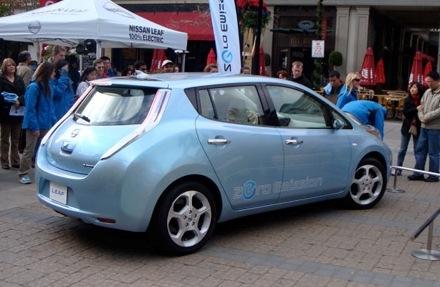California's zero-emission vehicle mandate could hurt automakers, but do we care?
August 17, 2011
It's hard to argue with all of the logical points posted to my earlier blog, {doclink 231279}.
In various comments, it was called "Orwellian," "radical," and an "overreach." Of all the comments on the blog and the numerous personal emails that followed, precisely zero thought it was a good idea.
Interestingly, though, no one expressed concern for the automakers. Most readers didn't like the idea of being told what to buy, but they had no apparent reservations about the proposed California mandate, which would fine the manufacturers $5,000 for each electric car they don't sell.

The all-electric Nissan Leaf.
Admittedly, it can be hard to sympathize with the plight of the automakers. They alienated countless customers in the 1970s by employing a "planned obsolescence" design philosophy, which resulted in some of the worst cars ever made. At various times, they fought fuel economy regulations, battled with unions, and resisted the introduction of new technologies, until governments nearly wrestled them to the ground.
So, yes, I understand that most consumers aren't enamored with the auto industry. But have we all forgotten about 2008? Have the GM and Chrysler bailouts slipped our minds? Do we recall that Ford Motor Co. came precariously close to begging for a government handout, too? And do we remember Toyota's troubles over the last few years?
If 2008 taught us anything, it should have been that none of the automakers have a giant stash of cash in a basement vault. There are no enclaves of executives who sit around, smoking cigars wrapped in $500 bills.
The lessons of 2008 -- which were repeated in countless newspaper articles -- should have been twofold: that the automakers are far more fragile than most of us guessed; and that bankrupt carmakers don't go down alone. Their pain spreads from the engineers and assembly line workers to their families, their towns, and to the thousands of suppliers that make tires, axles, seats, motors, bumpers, fuel tanks, light bulbs, semiconductor chips, and myriad other parts. The pain also spreads to the taxpayers who have to bail them out. The point is, bankrupting the automakers is not a prescription for national economic nirvana.
Most consumers, however, seem unconcerned. Auto companies are easy to bash. The assumption is that they're big and rich. And if they're not rich, all they need to do is tighten their belts a little.
Government regulators don't seem very sympathetic, either. California wants to charge them $5,000 for every electric car they don't sell. The Fed wants them to build cars that average 54.5mpg. Everyone, it seems, has an opinion on how automotive engineers should do their jobs. And, by the way, if they don't do it the way we tell them to, let's give 'em a kick.
But I'm not so sure the auto companies are as healthy as people think. To me, all this sounds like a great way to drive them back to the bailout days. California blames the auto industry, the politicians look decisive, and the residents don't have to share in the economic pain.
It all seems a little too easy.
For Further Reading
To keep up with our Chevy Volt coverage, go to Drive for Innovation and follow the cross-country journey of EE Life editorial director, Brian Fuller. On his trip, sponsored by Avnet Express, Fuller is driving a Volt across America to interview engineers.
About the Author(s)
You May Also Like



